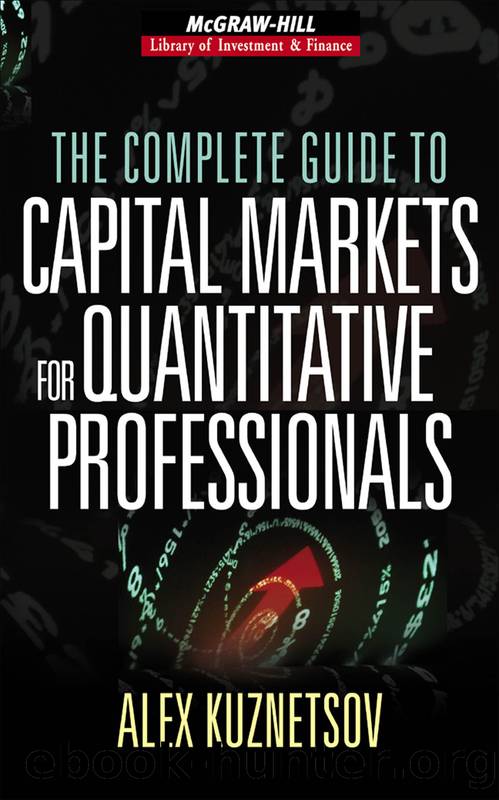Complete Guide to Capital Markets for Quantitative Professionals (9780071709521) by Kuznetsov Alex

Author:Kuznetsov, Alex
Language: eng
Format: epub
Publisher: McGraw-Hill Global Education
Published: 2007-10-15T00:00:00+00:00
FIGURE 9â6
Volatility of MSFT stock. The dotted line shows realized volatility (annualized standard deviation of daily returns) calculated over the past 30 days, while the solid line represents implied volatility based on observed options prices. Implied volatility data courtesy of IVolatility.com (www.ivolatility.com).
To find this implied volatility, we numerically invert the Black-Scholes formula (there is no analytical inversion); in our Dec 05 MSQ put example, we find that a volatility of 16.784 percent produces the observed price of this option (or, to illustrate the origins of the term, we can say that the price of $0.80 implies that the volatility should be 16.784 percent).4 Implied volatility is thus simply another way to express the options price and in no way explains why the price is what it is, but it is an extremely useful concept nonetheless as long as we understand its origins and its limitations.
In Figure 9â6 we compare the implied volatility of MSQ options with the historical (realized) volatility of MSFT stock; we can see that both are in the same ballpark numerically but can differ very significantly at any given time. A convenient way to think about the relationship between realized and implied volatility is to recognize that realized volatility is a backward-looking measure, while implied vol is forward-lookingâit represents the marketâs attempt to guess what the realized vol will be in the future.
Our implied volatility graph in Figure 9â6 is a bit of a cheat because there is in fact no single implied volatility for MSQ options. For example, if we take another option from Figure 9â2 (say, the Dec 05 25.00 call) and calculate implied vol based on its price, we will get 15.879 percentâadmittedly pretty close to what we got previously, but not exactly the same. If we keep calculating implied vol for options with different strike prices and then plot the results as a function of the strike price, we will typically find (as we show in Figure 9â7) that (1) implied vol is a convex function of the strike price (a phenomenon known as the volatility smile), and (2) it also slopes downward, so that the vol for higher strikes is lower; this is called volatility skew. Skew is less universal than the smile (it is almost always there for equity options, but not for other option types). The smile is said to reflect the fact that in reality the probability of large price movements is much higher than what the normal distribution would suggest (in other words, real-world distributions have fat tails).
Download
This site does not store any files on its server. We only index and link to content provided by other sites. Please contact the content providers to delete copyright contents if any and email us, we'll remove relevant links or contents immediately.
Rich Dad Poor Dad by Robert T. Kiyosaki(6185)
Pioneering Portfolio Management by David F. Swensen(6083)
How To Win Friends and Influence People by Dale Carnegie(4341)
The Money Culture by Michael Lewis(3851)
The Dhandho Investor by Mohnish Pabrai(3564)
The Wisdom of Finance by Mihir Desai(3531)
Liar's Poker by Michael Lewis(3228)
The Intelligent Investor by Benjamin Graham Jason Zweig(2936)
The ONE Thing by Gary Keller(2922)
Mastering Bitcoin: Programming the Open Blockchain by Andreas M. Antonopoulos(2895)
Fooled by Randomness: The Hidden Role of Chance in Life and in the Markets by Nassim Nicholas Taleb(2867)
Rich Dad Poor Dad: What The Rich Teach Their Kids About Money - That The Poor And Middle Class Do Not! by Robert T. Kiyosaki(2836)
Investing For Dummies by Eric Tyson(2799)
How to Win Friends and Influence People by Dale Carnegie(2799)
How to Day Trade for a Living: Tools, Tactics, Money Management, Discipline and Trading Psychology by Andrew Aziz(2787)
Market Wizards by Jack D. Schwager(2545)
Zero Hour by Harry S. Dent Jr. & Andrew Pancholi(2537)
How to Pay Zero Taxes, 2018 by Jeff A. Schnepper(2503)
Rich Dad's Guide to Investing by Robert T. Kiyosaki(2412)
